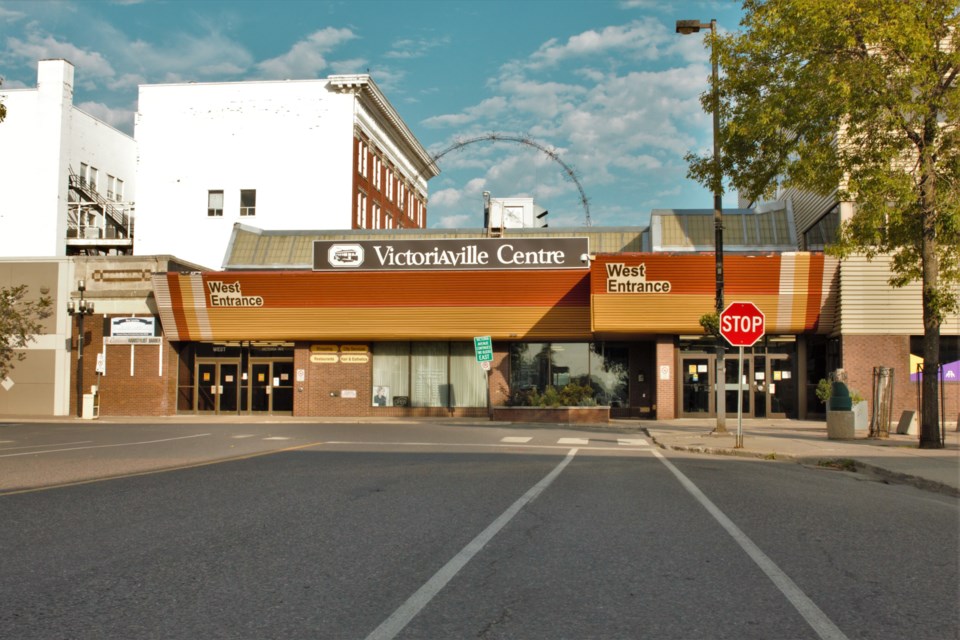THUNDER BAY – With four weeks until Thunder Bay city council decides the future of the Victoriaville Centre, councillors received a report recommending its removal Monday night.
With a reminder from Mayor Bill Mauro that discussion was limited to asking questions – debate over the issue is reserved for a vote on Oct. 19 – councillors raised issues of financing, social equity, and possibilities for the area’s future as they considered the report’s findings.
The option to fully remove the city-owned shopping centre, favoured by consultant Urban Systems, is estimated to cost the city $10.75 million. That figure includes demolition, street improvements, the addition of plazas and public squares, and other project costs.
The adjacent city parkade would be left standing.
The cost of removal would pay off after about ten years, since the city would no longer face large annual operating losses. Victoriaville lost $684,000 in 2016 and faces an estimated operating loss of $824,000 by 2025. Total losses over a 10-year periord are about $9.3 million.
Three other options were considered in the report: a partial removal that would leave a renovated section of the structure along Syndicate Avenue, repurposing the centre for non-commercial community uses, or attempting to revitalize it as a retail space.
The full removal option scored highest on 8 of 10 evaluation criteria, with the others found to be significantly more expensive and generally less beneficial.
A team of urban planners, architects and landscape architects, structural and civil engineers, land economists, and retail experts contributed to the 200-page report backing the recommendation.
In a presentation to councillors, Urban Systems project manager Jeff Palmer emphasized that few communities of Thunder Bay’s size were able to support downtown shopping malls, characterizing them as a dated urban planning approach.
The report instead paints a picture of a pedestrian-friendly alternative that could attract more residents to the area for events and “unique retail experiences” such as temporary markets.
“Amenities such as street trees, benches, decorative lighting, and on-street water treatment will provide a pleasant environment that encourages pedestrians to linger,” the report describes. “The design of the street would support this purpose, as opposed to moving cars quickly through the neighbourhood”
“The public plazas to be developed within the Syndicate Avenue right of way have the potential to become significant public gathering areas.”
It’s an option that garnered strong support in public consultations. Of several hundred residents who participated in surveys and town halls in the fall and winter, 81 per cent agreed the cost to demolish Victoriaville and reopen Victoria Avenue was justified given an approximately 10-year payback period.
Palmer cautioned council, however, that its larger goal of renewing the south core was one that would take time and sustained effort beyond the removal of Victoriaville.
“This takes time – it takes decades,” he said. “There’s no silver bullet. You need a hundred small, incremental projects on a sustained basis.”
Current River councillor Andrew Foulds pressed Palmer on the implications of tearing down Victoriaville for street-involved residents who rely on it. Issues of equity and liveability were the only two criteria where the full removal option scored lower than other alternatives.
“Certainly we have some criminal element that’s there, and you definitely have a demographic that’s living on the fringes,” Foulds said. “This is an area where they go.”
“I understand the planning arguments you’re making, [but] this doesn’t solve those issues, it moves them along. What happens to those people who get some reprieve in Victoriaville?”
The plan would need to be accompanied by a comprehensive strategy by the city and social service agencies to address the removal of Victoriaville, Palmer replied. Preliminary discussions on the topic had already begun, he said.
“I wouldn’t say that the goal of this project is to move people along,” he told councillors. “The goal… is to create infrastructure that will support positive uses.”
The removal would also displace several businesses in the centre, though the report noted attracting commercial tenants was a challenge, with much of the centre rented by the city itself.
Coun. Rebecca Johnson requested more information from city administration on the loss of tax revenues from those businesses, as well as where the city would find the $10.75 million to finance the plan, before the decision came back for a vote on Oct. 19.
